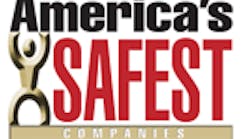“First and foremost, all we have is people - good people doing hard work every day,” says Bill Pratt, vice president of health, safety, environment and Six Sigma at The Mundy Companies. “People are our most important asset.”
Pratt's attitude reflects the company's insistence that safety is not only a core value, but also a corporate value. And it's been that way for more than 50 years. When A.J. Mundy founded The Mundy Companies in 1954, he envisioned an organization committed to actively caring about people, that maintained visible leadership and that empowered all employees to work safely.
“We believe in our work environment, all employees can excel and work injury-free,” Pratt says.
As a maintenance small-project construction and services work company, Mundy's 6,500 employees face a range of hazards, including construction hazards, chemical exposures, dangers associated with the petrochemical industry and more. Despite these risks, the company logged a lost-time injury rate of only .25, compared to the industry average of 3.2. Mundy also has won various safety awards from the Associated Builders and Contractors, the Texas Safety Association, the North Carolina Department of Labor and more. In addition, several Mundy sites were awarded VPP Star Site recognition.
“Working safely is a condition of employment at The Mundy Companies,” Pratt says. “We continually emphasize our safety expectations.”
Those expectations take the form of seven company safety principles:
- People are our most important asset.
- All incidents and injuries are preventable.
- Safety is everyone's responsibility.
- Leadership has the responsibility to train employees to work safely and to develop a “work-safe” culture.
- Working safely is a personal responsibility and a condition of employment.
- All tasks must be planned and performed with a concern for safety.
- Working safely makes financial sense.
TIME FOR SAFETY
Pratt says Mundy workers remain safe in part because the company gives employees the time to mitigate hazards. That means no one is expected to rush through a job if it could compromise safety in any way.
“We ask each of our employees not to perform work that they feel is unsafe. They have the time given to them to make the work safe,” Pratt explains.
The company accomplishes this by requiring employees to follow a 5-step process before initiating any task. Employees must consider the following questions before beginning work:
What am I about to do?
How am I going to do it?
What do I need to do the job?
How can I be injured? and
What am I going to do about it?
These questions and additional information are included on the company's 3-in-1 cards, which must be completed before every task and then turned in to field leadership. The card includes the 5-step planning process, a comprehensive hazard recognition checklist, information related to hand and back safety and a safety awareness section where workers fill out their observations, actions taken and suggestions for improving the job. This process also drives business performance, Pratt says.
“The quality of the cards are indicators of how well employees are doing in the field,” he explains.
Mundy also developed a company-wide stretching program, Ergonomics in Action, to help reduce sprains and strains. Employees can stretch for 5 minutes in the morning and also are encouraged to stretch at their workstations. The company also maintains employee-driven safety committees and a continual improvement process. It's all a part of putting people first and expecting nothing but the best.
“Safety is and always will be our No. 1 value,” Pratt says. “Our expectation is no one gets hurt. It's as simple as that.”
Return to America's Safest Companies

